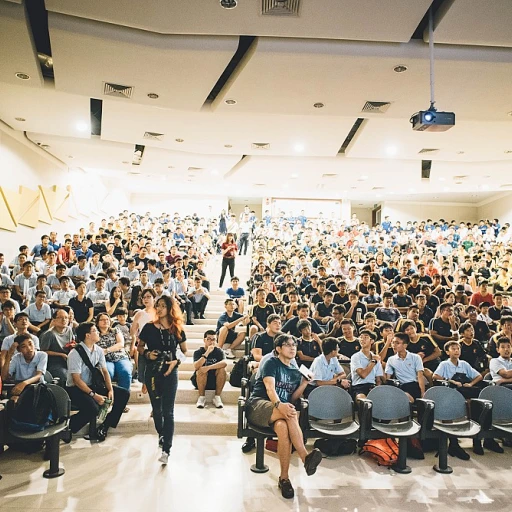
Understanding Training Modalities
Deciphering Diverse Learning Pathways
In today's fast-paced world, the pursuit of continuous learning has become a necessity rather than an option. Training, now more than ever, demands effective modalities to cater to diverse learners. Understanding these training modalities helps learners, employees, and students alike to maximize the potential of educational content across different levels and intensities. But what exactly are these modalities?
Training modalities refer to the various methods employed to deliver educational content and facilitate learning. They consist of instructor-led training, e-learning programs, blended learning approaches, and virtual learning environments, each designed to align with specific learning objectives.
Instructor-led training, for example, is one of the more traditional methods. It revolves around face-to-face interactions on a campus, ensuring direct engagement with instructors. Although deeply rooted in established teaching methods, it may not always accommodate all learning styles, particularly in a world that increasingly values flexibility.
On the other hand, e-learning courses offer a virtual platform, giving learners the freedom to engage with training content from anywhere. This modality often includes interactive learning activities, where learners can self-pace through the course modules, engaging actively to enhance their learning experience.
Blended learning combines the best of both these worlds. By integrating the physical presence of instructor-led sessions with the autonomy of online platforms, it adapts to the varying needs and intensities of individuals. Such approaches promote a balanced learning modality, especially in employee training scenarios where job-specific skills are honed alongside theoretical insights.
Furthermore, an increasing interest in modalities training like body weight or interval training also highlights how training regimes extend beyond mental skills to physical abilities, often tied to heart rate and aerobic levels. These days, training content isn't limited to the confines of a classroom but extends to comprehensive programs designed to cater to holistic personal development.
Understanding these diverse pathways can significantly influence learner outcomes, paving the way for future trends that continuously reshape the landscape of educational training programs. For a deeper dive into how training modalities can be documented effectively, one can explore crafting an effective documentation policy for continuous learning here.
Blended Learning Approaches
How to Combine Different Training Modalities for Better Learning
Blended learning is becoming a popular approach that combines both traditional and modern training methods to provide a more comprehensive learning experience. This modality effectively merges instructor-led training with online learning, creating dynamic content that caters to varying learning preferences and objectives. Learners can benefit from both face-to-face interactions and the flexibility offered by online platforms, enabling them to access training content on demand.
The essence of blended learning lies in its ability to integrate diverse learning activities that appeal to different learning modalities. For instance, some participants may prefer eLearning courses that allow them to control the pace and intensity of their studies, while others may benefit from the structured environment of a campus setting. By incorporating body-weight exercises and virtual aerobic programs, training can become more engaging and effective, catering to the unique needs of the learners.
Key Elements to Consider in Blended Learning:
- Course Modalities: Blending in-person and virtual sessions encourages habits that challenge the learners' body and mind, promoting a holistic learning experience.
- Training Program Pupils: Tailoring program intensity and volume according to learners' levels helps in maintaining an ideal heart rate and engagement.
- Schedule Flexibility: Allowing students to choose the number of days per week they wish to participate in training modalities ensures sustained participation and achievement of learning objectives.
By exploring and implementing blended learning approaches, organizations can effectively utilize modalities training and enhance employee training programs. To master the art of combining these methods, check out mastering antibody-based training.
The Role of Technology in Training
The Impact of Technological Advancements on Training Modalities
In the landscape of continuous learning, the role of technology cannot be overstated. It has transformed traditional training methodologies, offering a plethora of options that cater to the diverse learning styles of individuals. As organizations strive to keep pace with evolving industry demands, embracing technological advancements in their training programs becomes vital.
One of the most significant technological contributions is the ability to deliver online training content. Virtual platforms allow learners to engage with material at their own pace and convenience, thus accommodating various learning modalities. This flexibility also extends to virtual campus courses where learners interact in real-time, meeting other students from around the globe.
E-learning has made customizable learning paths more accessible, with technologies that adjust training intensity and scope according to the learner’s level. For example, interactive content such as simulations or immersive virtual experiences can elevate heart rates akin to aerobic exercises, depending on the learner’s body weight and course demands. This kind of interval training program can boost engagement and deepen understanding.
Blended learning approaches, integrating both online and instructor led training, leverage technology to enhance instructional design and meet specific learning objectives. Such courses often combine several days a week of dedicated online learning activities with periodic face-to-face interactions, ensuring that learners are fully engaged and actively participating in the training process.
Ultimately, these technologies provide employees with varied learning opportunities and modalities, contributing to a comprehensive and effective training experience. As technology continues to evolve, so too must our training modalities, ensuring they remain relevant and impactful in an increasingly digital world. For more insights into handling shifts in the industry, you might find this navigating challenges in the professional training and coaching industry article informative.
Personalized Learning Paths
Crafting Tailored Learning Experiences
In the realm of continuous learning, personalized learning paths have emerged as a pivotal strategy to enhance the effectiveness of training programs. Unlike traditional one-size-fits-all approaches, personalized learning acknowledges the diverse needs and preferences of learners, offering a more customized experience.
Personalized learning paths leverage various training modalities to cater to individual learning styles and paces. For instance, some learners may thrive in an online course environment, while others benefit more from instructor-led training. By integrating different learning modalities, such as virtual classrooms and eLearning platforms, organizations can create a blended learning experience that resonates with each learner.
Utilizing Data for Personalization
Data plays a crucial role in shaping personalized learning paths. By analyzing learners' progress, preferences, and performance, training programs can be adjusted to better meet individual needs. This data-driven approach ensures that the training content remains relevant and engaging, ultimately leading to improved learning outcomes.
Moreover, personalized learning paths can incorporate various intensity levels and modalities training, such as interval training for skill development or body weight exercises for practical application. This flexibility allows learners to engage with content that aligns with their current skill level and learning objectives.
Benefits of Personalized Learning
- Increased Engagement: Tailored content keeps learners motivated and invested in their training journey.
- Improved Retention: Personalized learning paths help reinforce knowledge by aligning with learners' unique needs.
- Enhanced Performance: By focusing on individual strengths and areas for improvement, learners can achieve better outcomes.
As organizations continue to explore effective training modalities, the emphasis on personalized learning paths will likely grow. By embracing this approach, companies can ensure that their training programs are not only effective but also adaptable to the evolving needs of their workforce.
Evaluating Training Effectiveness
Methods to Assess Training and Learning Outcomes
Evaluating the effectiveness of training modalities is crucial for ensuring that the learning objectives are met. This assessment not only highlights the success of online and instructor-led courses but also aids in refining instructional design. To accurately measure effectiveness, here are key elements to consider:- Learner Engagement Metrics: Evaluate the levels of engagement by tracking participation in both virtual and campus-based learning sessions. Metrics such as course completion rates and interaction levels during eLearning or traditional classes provide insights into learner involvement.
- Pre- and Post-Assessment Scores: Tools that compare learner performance before and after the completion of a course modality, such as interval training programs or body weight and aerobic courses, are effective. This approach assesses the cognitive gains achieved through various training modalities.
- Feedback Mechanisms: Collecting feedback from students or employees after a training program helps identify areas of improvement within the training content. Surveys and feedback forms can reveal how well learners perceive the training's applicability and relevance to their roles.
- Learning Path Adjustments: Personalized learning paths should be adapted according to the evaluation results. For example, weight and intensity levels of training courses can be adjusted based on learner progress, enhancing learning activities' effectiveness.
- Behavioral and Performance Changes: Evaluate changes in behavior or performance on the job as a result of training. This includes tracking improvements in work quality, efficiency, or heart rate monitoring in wellness programs, signaling the training’s applicability in real-world scenarios.
- Longitudinal Studies: Conducting studies over extended periods allows practitioners to observe the lasting impacts of training, including how well knowledge and skills are retained.
Future Trends in Training Modalities
Emerging Trends and Innovations
With the rapid pace of technological advancements and the evolving needs of learners, the future of training promises to be dynamic and transformative. Here are some trends and innovations shaping tomorrow's training landscape:- Increased Integration of Technology: As seen in training programs, the use of virtual reality and augmented reality is becoming more prevalent. These technologies simulate real-world scenarios that enhance learning experiences by offering interactive and immersive training content that can adapt to various training modalities.
- Data-Driven Decision Making: The implementation of analytics to track heart rate, intensity levels, and other metrics during training is not just confined to physical activities like aerobic and interval training. Online and eLearning platforms also utilize data to assess learners’ progress, identify learning objectives, and adjust instructional design accordingly to enhance training effectiveness.
- Focus on Personalized Learning: Just as blended learning combines multiple course modalities, the future of employee training will likely continue emphasizing personalized learning paths. This approach caters to individual needs, thereby maximizing engagement and retention among learners, whether they are students, employees, or participants in a virtual campus environment.
- Expansion of Blended Learning: By providing a mix of instructor led, online, and self-paced courses, blended learning remains a robust modality. It combines the social benefits and immediate feedback of led training with the flexibility of online learning, a model that is adaptable and sustainable for changing educational landscapes.
- Increased Emphasis on Continual Learning: With the weight of constant innovation, organizations recognize the necessity of continuous training. Thus, programs are increasingly designed to accommodate ongoing employee development over a span of days a week, enhancing skills at every career stage.












